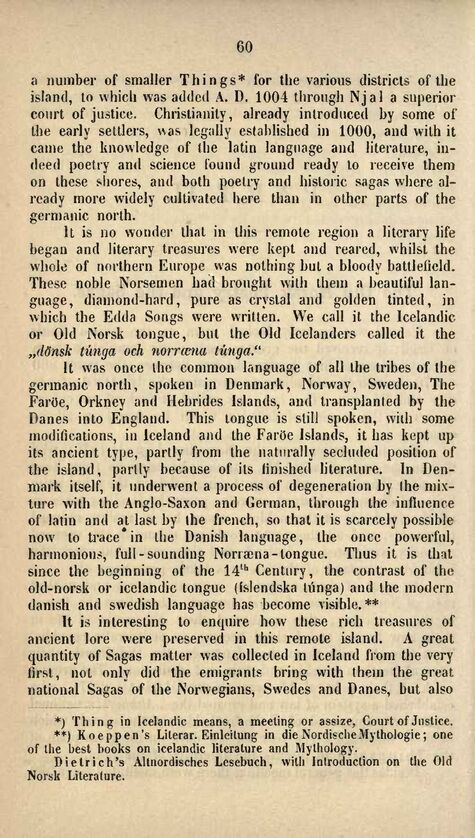
Full resolution (JPEG) - On this page / på denna sida - The Old Norsk Poetry and the Sagas

<< prev. page << föreg. sida << >> nästa sida >> next page >>
Below is the raw OCR text
from the above scanned image.
Do you see an error? Proofread the page now!
Här nedan syns maskintolkade texten från faksimilbilden ovan.
Ser du något fel? Korrekturläs sidan nu!
This page has been proofread at least once.
(diff)
(history)
Denna sida har korrekturlästs minst en gång.
(skillnad)
(historik)
a number of smaller Things [1] for the various districts of the
island, to which was added A. D. 1004 through Njal a superior
court of justice. Christianity, already introduced by some of
the early settlers, was legally established in 1000, and with it
came the knowledge of the latin language and literature,
indeed poetry and science found ground ready to receive them
on these shores, and both poetry and historic sagas where
already more widely cultivated here than in other parts of the
germanic north.
It is no wonder that in this remote region a literary life
began and literary treasures were kept and reared, whilst the
whole of northern Europe was nothing but a bloody battlefield.
These noble Norsemen had brought with them a beautiful
language, diamond-hard, pure as crystal and golden tinted, in
which the Edda Songs were written. We call it the Icelandic
or Old Norsk tongue, but the Old Icelanders called it the
„dönsk túnga och norræna túnga.“
It was once the common language of all the tribes of the
germanic north, spoken in Denmark, Norway, Sweden, The
Faröe, Orkney and Hebrides Islands, and transplanted by the
Danes into England. This tongue is still spoken, with some
modifications, in Iceland and the Faröe Islands, it has kept up
its ancient type, partly from the naturally secluded position of
the island, partly because of its finished literature. In
Denmark itself, it underwent a process of degeneration by the
mixture with the Anglo-Saxon and German, through the influence
of latin and at last by the french, so that it is
scarcely possible now to trace in the Danish language, the once powerful,
harmonious, full-sounding Norræna-tongue. Thus it is that
since the beginning of the 14th Century, the contrast of the
old-norsk or icelandic tongue (íslendska túnga) and the modern
danish and Swedish language has become visible.[2]
It is interesting to enquire how these rich treasures of
ancient lore were preserved in this remote island. A great
quantity of Sagas matter was collected in Iceland from the very
first, not only did the emigrants bring with them the great
national Sagas of the Norwegians, Swedes and Danes, but also
<< prev. page << föreg. sida << >> nästa sida >> next page >>